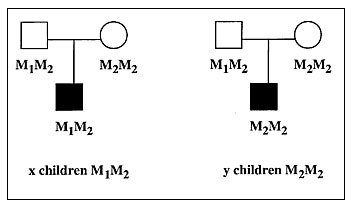Volume 4, Number 4—December 1998
Synopsis
Genetic Epidemiology of Infectious Diseases in Humans: Design of Population- Based Studies
Figure 3

Figure 3. Principle of the transmission disequilibrium test (TDT) for investigating association between a disease and allele M1. The sample consists of x+y families with one affected child and two parents. For ease of presentation, we assume that only one parent is heterozygous for M1 (e.g., M1M2), although the second parent could be used for the test if he were himself heterozygous for M1. There are x affected children who have received allele M1 from their M1M2 parent and y who have received M2. The TDT statistic is simply (x-y)2/(x+y), which is distributed as a chi-square with one degree of freedom.
Page created: December 16, 2010
Page updated: December 16, 2010
Page reviewed: December 16, 2010
The conclusions, findings, and opinions expressed by authors contributing to this journal do not necessarily reflect the official position of the U.S. Department of Health and Human Services, the Public Health Service, the Centers for Disease Control and Prevention, or the authors' affiliated institutions. Use of trade names is for identification only and does not imply endorsement by any of the groups named above.